Electric vehicle technology is on a steady course to eventually take over much of the world’s transportation sectors, from the automobile to the urban scooter. But there are some industries where today’s EV tech still lags behind fuel-burning engines – most notably, aviation. Battery-powered planes struggle with weight and short range, but one startup company is taking a surprisingly reasonable approach with a logical design. The Beta Technologies Alia isn’t trying to reinvent the wheel and isn’t trying to be a real-life version of some sci-fi craft. Instead, it’s just a regular, albeit weird, electric plane that Beta hopes will make short-haul package delivery and organ transport much cleaner.
Aviation gets pretty dirty, from the tons of jet fuel burned each year to the leaded gasoline that’s still consumed by most of the general aviation fleet. The industry is acutely aware of this, and there have been some exciting developments to clean things up. Unleaded aviation gasoline is getting better every year and, despite decades of roadblocks, is managing to spread its way through general aviation. I genuinely believe the day that leaded avgas dies is coming, and hopefully coming sooner rather than later.
Of course, the cleanest plane is one that doesn’t burn any fuel at all. Unsurprisingly, everyone from startup companies to household names is working on electrified flight.

As I’ve written before, today’s battery technology is fantastic for cars, but poses several challenges for a plane builder. As of right now, the best way to increase range in an EV is through piling on batteries. Cars can get away with comically huge batteries and 9,000-pound curb weights, but it’s a problem for aircraft, where every pound counts. Generally speaking, a plane with more batteries will carry a smaller payload. There are also diminishing returns, as more batteries add more weight, which requires more powerful engines to move and an airframe to carry the load. Of course, those batteries also cost a lot of money, too.
Because of these limitations and more, there is no true long-haul electric aircraft yet. There are electric aircraft in production and in service, but you’ll note that almost all of them have a low range that largely limits them to hopping between sister cities, if that. Most of the companies working on and building electric aircraft are either focusing on toys, like the Jetson One ultralight electric vertical take off and landing aircraft (eVTOL), a whole slew of air taxis, lots of “flying cars,” or super short-haul electric airliners.

Most of these aircraft look flashy and generate tons of headlines, but a lot of them just aren’t very realistic. Despite what you might have read, a personal eVTOL like the Jetson One is not a “flying car” and will never be one. You cannot fly one to work in the city, and given their six-figure price tags, a typical person cannot afford one, anyway.
The eVTOL air taxis that are sometimes heralded as the future of flight will realistically just replace the helicopter airlines of decades ago. They have the same range issues noted above, too.
When I went to EAA AirVenture Oshkosh 2025, I found an electric plane that stood out, not because it was draped in promises of disruption or changing the world, but because it was so normal. The Beta Alia is just a plane, but electric, and it seems flexible enough to have real practicality in short-range cargo flights and organ transport.
Serving A Different Niche

Beta Technologies is one of many companies working on electric aviation, but its approach has been different than many companies.
Beta was founded in 2017 by pilot and engineer Kyle Clark. His company’s overall goal doesn’t sound a whole lot different than the other dozens of companies in this space, and he wants to create an eVTOL. Where it first departs from the norm is the reason why. Instead of an air taxi, Beta Technologies wants to focus on medical aviation, specifically, Beta’s eVTOL is being designed to transport manufactured organs for United Therapeutics. Beta also sees the passenger version of its eVTOL transporting patients.
Beta’s early development was quiet, but rapid. The company achieved its first flight with a prototype, the Ava XC, in May 2018. That alone is pretty interesting, as many eVTOL startups spend years with only renders. The Ava XC featured a cabin from a Lancair ES, but with carbon fiber booms from Blue Force Technologies, which have a total of eight 124 HP electric motors and eight propellers.

Clark believes in his company’s tech enough to have personally flown hundreds of test flights. According to electric aviation publication evtol.com, Clark has been an airplane fanatic since he was a kid, and built his first plane, a homebuilt ultralight, in high school. He studied applied mathematics and materials science at university while also playing hockey. Clark was drafted by the Washington Capitals, and used the money he got from signing onto the team to pay for flying lessons. Today, Clark is an engineer and an accomplished pilot. For his Beta project, Clark learned how to fly helicopters and also became a test pilot. Reportedly, Beta Technologies has an approved simulator training program. This program was developed by Austin Meyer, an avgeek most famous for the creation of the X-Plane flight simulator.
The Alia
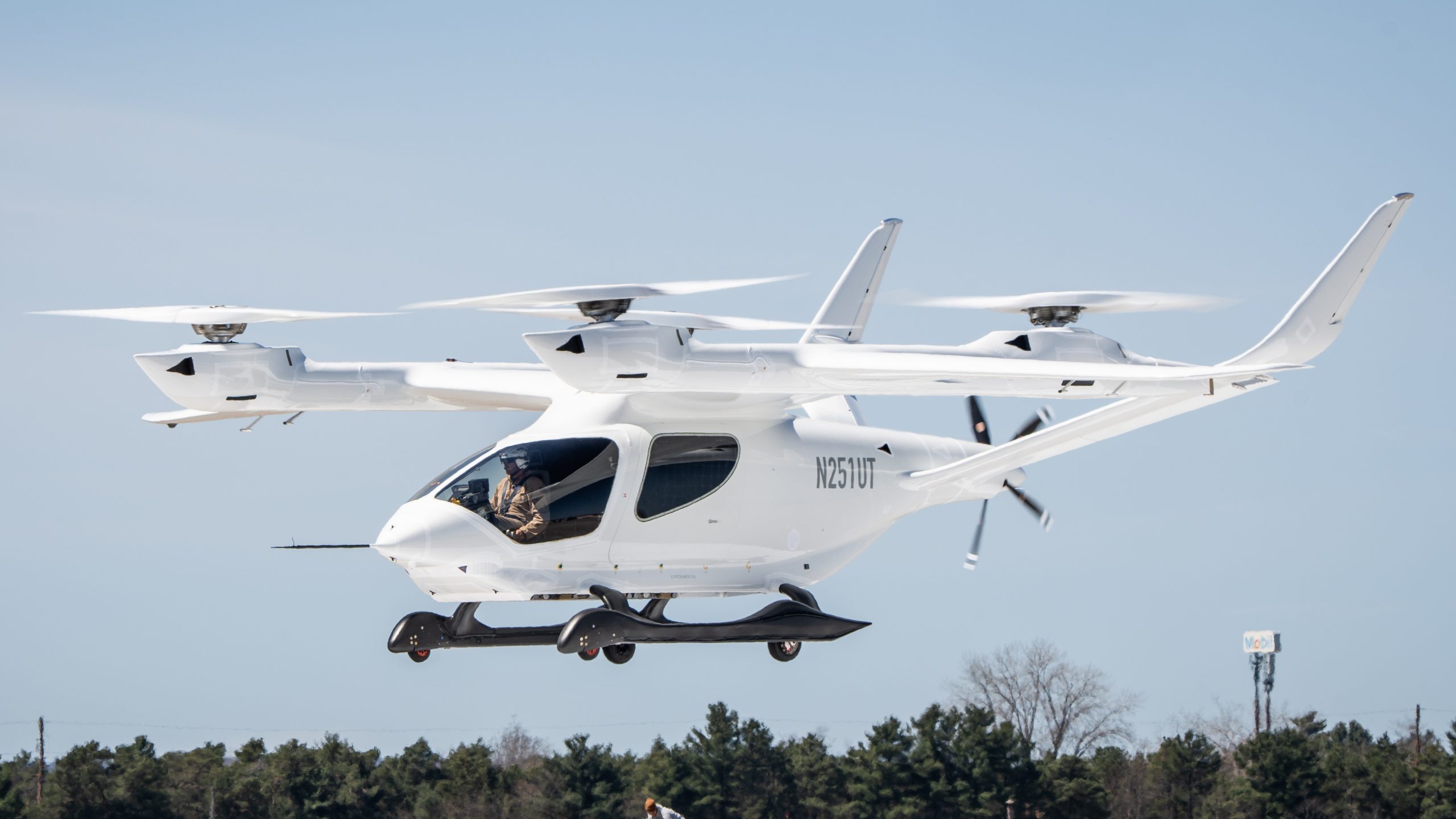
The Ava XC was rough around the edges, but it was proof that Beta meant business. Next would come the weird plane we’re looking at today, the Alia. The Beta Technologies Alia A250 was unveiled in June 2020. This aircraft features one pusher prop in the rear for forward propulsion, four rotors on two booms for eVTOL operations, and a carbon fiber fuselage. Beta says that the 50-foot wingspan, the long V-tail, and the general shape of the lift surfaces are designed to lower drag for more range, but also to increase maneuverability for slow flight. Beta also says that the design that you’re looking at here was done in the name of simplicity.
Like its Ava predecessor, the Alia was initially aimed at the medical transport arena, with the idea being that the aircraft would fly between hospitals. However, Beta also sees its aircraft being great for short-haul cargo runs.

The Alia platform is said to weigh around 6,000 pounds and has an all-electric range of 250 miles. Normally, range claims are a huge question mark, but Beta is quite obsessed with actually flying its aircraft. After successful ground tests and tethered test flights in 2020, the Alia prototype has been flying around untethered since 2021. The plane’s been just about everywhere. In 2022, the Alia flew 1,400 miles from New York to Arkansas, stopping for charging along the way. Later that year, the aircraft flew 876 miles to the UPS Worldport in Kentucky.
Beta would perform lots of flights like this, including a transcontinental flight, and just like the concept of winning a race and selling cars after, actually flying some real aircraft got customers on board. United Parcel Service entered into a contract for 10 Alia aircraft in 2021, with an option to buy 150 more. UPS would love to use its Alias to fly directly between its centers rather than having to touch down at major hub airports.
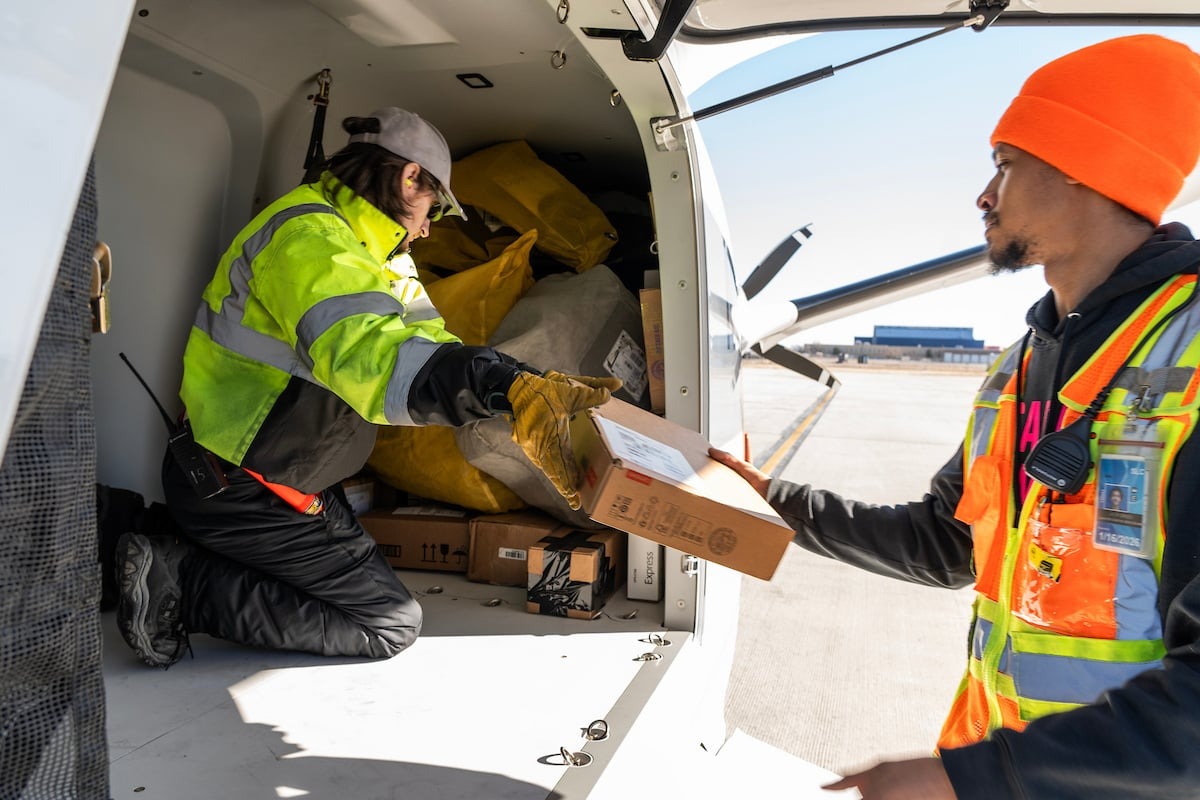
Urban transport service Blade Urban Air Mobility then committed to purchase up to 20 Alia. Later orders would come from aircraft lessor Lease Corporation International, helicopter airline Bristow Norway AS, medical transport service Metro Aviation, and the New Zealand Air Ambulance Service.
Through all of these orders, the folks of Beta learned something perhaps unexpected: A lot of folks loved the Alia concept, but didn’t care a whole lot about the eVTOL part. They just wanted an electric conventional plane with a 250-mile range. So, in 2023, Beta announced the Alia CX300, which is just the Alia A250 without VTOL capability. Given the huge interest in just a regular electric plane, Beta has decided to put the CX300 into production first. The CX300 is the aircraft that I saw fly at Oshkosh.
The CX300

The production Alia CX300, which I got to see in person, is a pretty slick aircraft. The basic carbon fiber and aluminum construction of the base Alia makes it over. As stated earlier, this conventional airplane, so no VTOL capability, has a 50-foot wingspan. It’s capable of a top speed of 153 knots (176 mph), and the Beta team has demonstrated the aircraft to have a range of 336 nautical miles. The Alia CX300 can be flown by one or two pilots and is instrument-flight-rules capable. Nothing too amazing thus far, but hold tight.
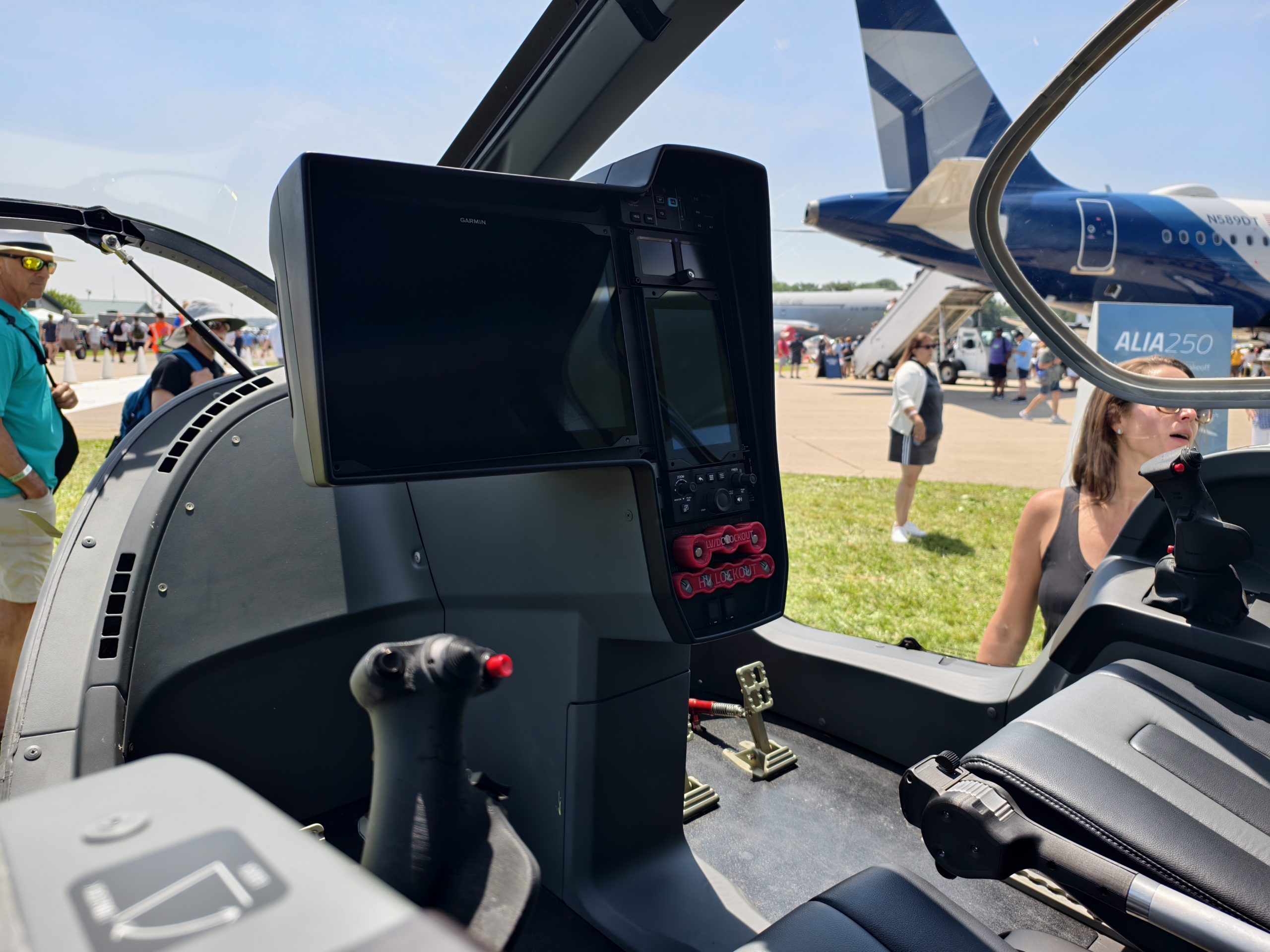

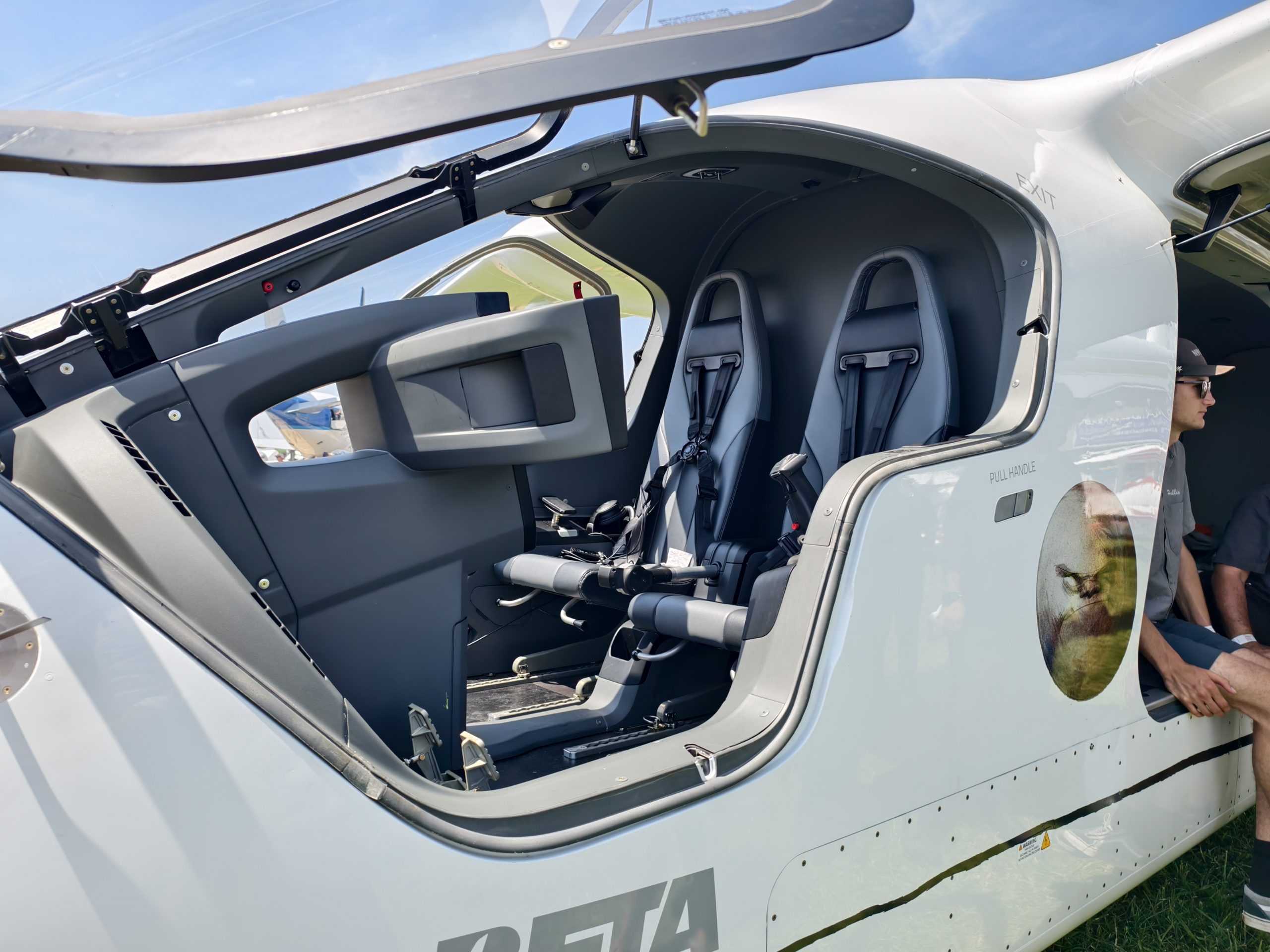
Located in the rear is a five-blade prop, which is driven by Beta’s H500A electric motor. Beta says that this motor has a peak output of 572 HP, but runs at 528 HP during takeoff. Maximum continuous power is 402 HP. This motor also punches out 1,087 lb-ft during takeoff and 829 lb-ft continuously. The motor, including its inverters, weighs just 156 pounds, and Beta says the motor’s service ceiling is 14,000 feet. Beta also says that its motors have the equivalent of 70,000-equivalent flight hours of prop-stand testing.
Powering that motor is a set of five 45 kWh batteries, adding up to 225 kWh of energy. Beta says that each 45 kWh pack weighs 562 pounds and is rated at 832 volts each. These batteries can be fast-charged in under an hour. If you do the math, you can see what I mean about how much today’s batteries impact aircraft. This plane is carrying 2,810 pounds in batteries alone! The twist is that, unlike a plane that burns fuel, this aircraft won’t get lighter as it flies. That’s why Beta worked so hard to cut drag and weight from other areas.

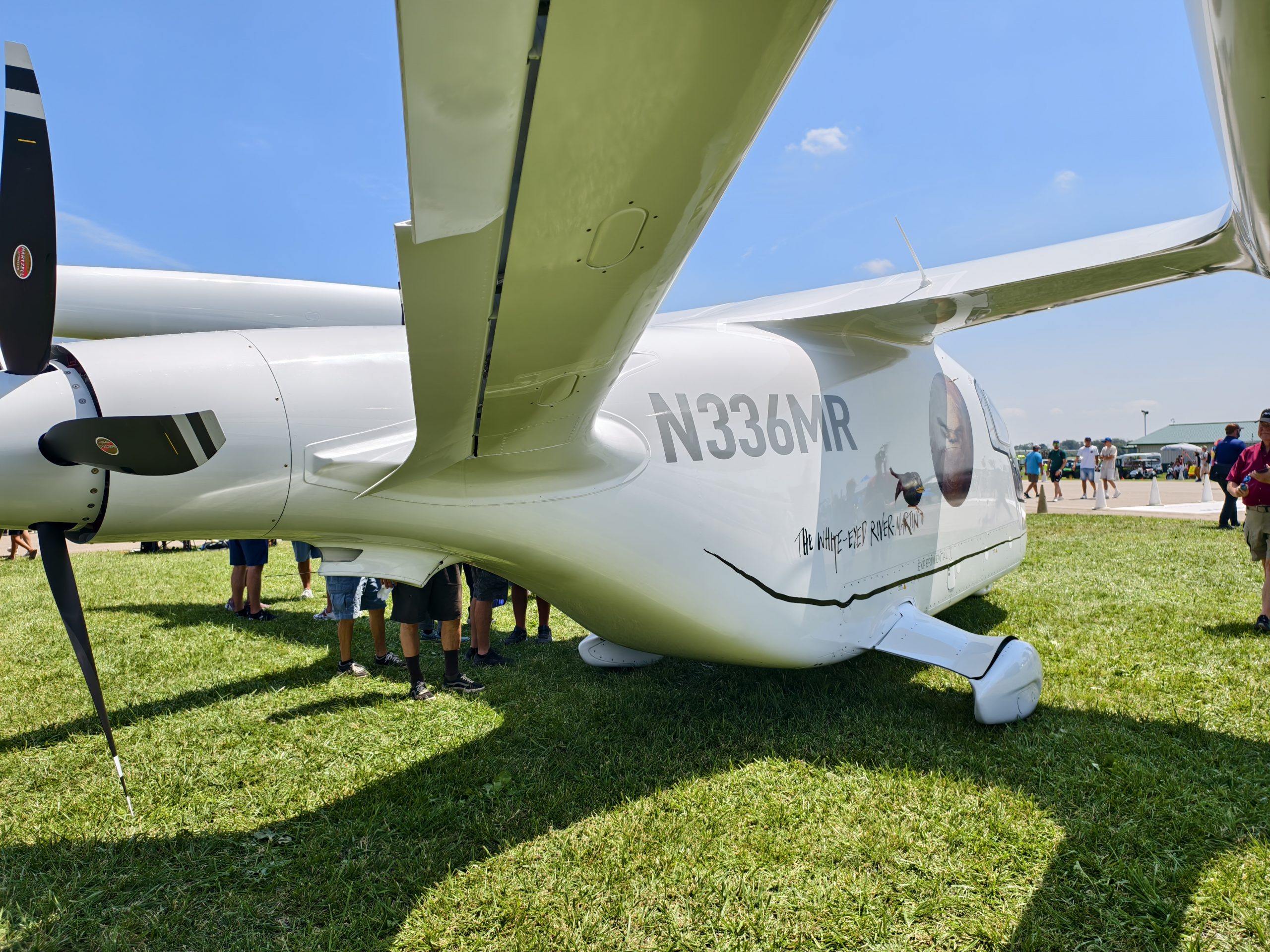
The Alia’s controls and systems are managed through flight computers, and the flight deck should look familiar to any pilot. Really, what’s amazing about the Alia CX300 is how normal it seems. Beta’s plane doesn’t have a ton of sizzle like those air taxis and personal eVTOLs. It’s just a plane that looks weird.
In terms of carrying capability, you’re looking at enough room for five passengers or 200 cubic feet of cargo. That’s not a lot of room, but it’s apparently enough to keep UPS and the like interested in the standard airplane version of the Alia.


Since the Oshkosh show, Beta has made its first delivery, with helicopter airline Bristow Norway AS taking possession of the first customer Alia CX300. The plane is undergoing testing in Norway now before Bristow figures out what the aircraft will be best suited for. What’s pretty cool is how the Alia got there. It was loaded onto a ship and sailed out. When it arrived in Ireland, its first stop in Europe, the next problem was that it couldn’t fly from a seaport. So, a Bell 205A helicopter airlifted the Alia and delivered it to Shannon Airport.
According to Beta, the aircraft then flew 4,335 miles around Europe before landing in Bristow’s hands.
The Future
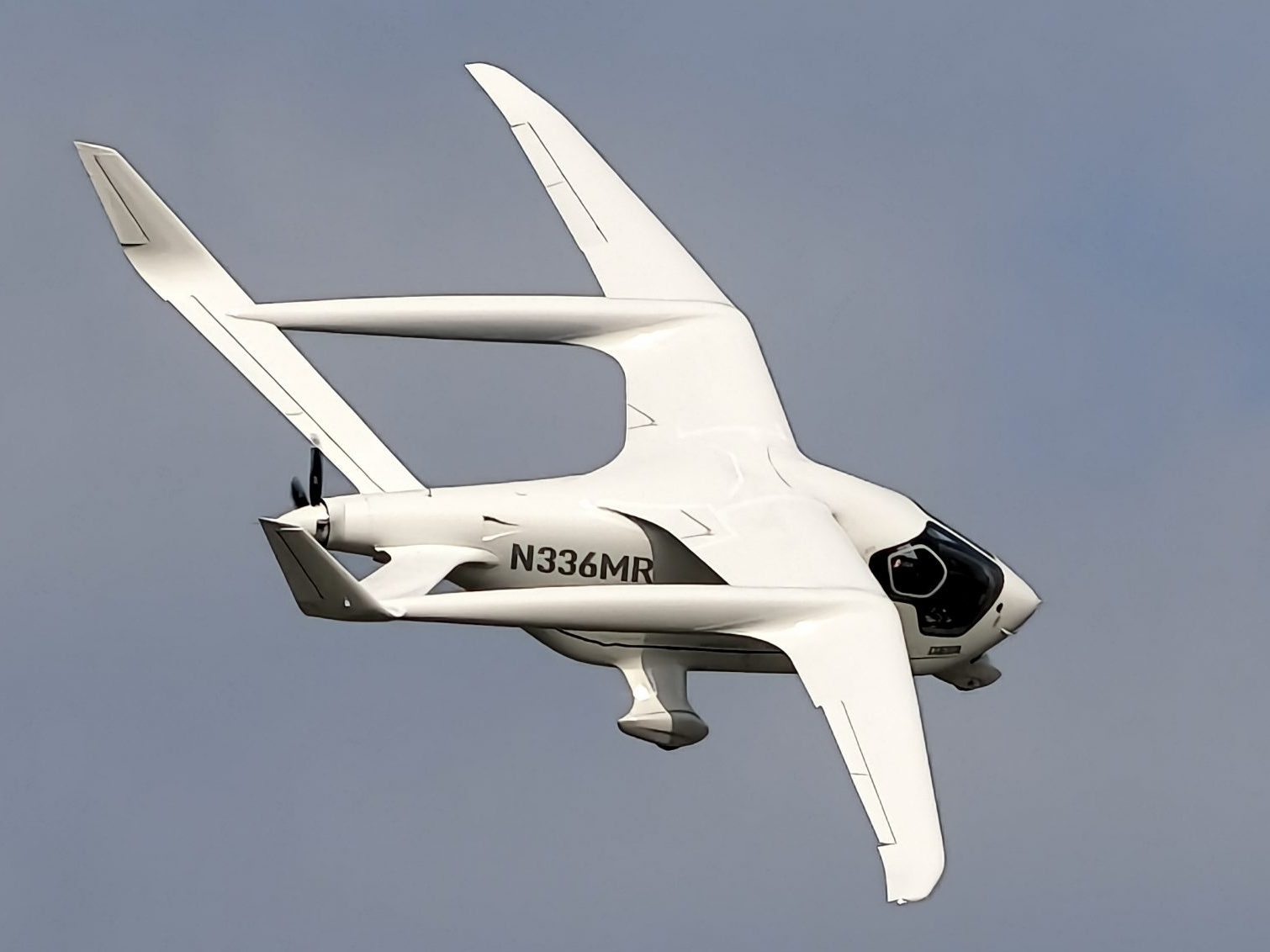
While Beta has demonstrated the ability to go further with electric technology than many companies in this space, it still has a way to go. Beta still needs to get FAA type certification here in America, which it hopes to achieve by the end of the year. The company also still needs EASA certification, too, so there isn’t only one Alia buzzing around Europe. However, given Beta’s progress thus far, these hurdles don’t seem insurmountable.
Of course, there are other figures that Beta needs to publish, like actual range figures, payloads, gross weights, price, and other data. Then, the company has to deliver the aircraft to its hungry customers. At some point, it’ll then get back to the eVTOL version of the Alia and, if Beta’s predictions are accurate, put that into production before the end of the decade.

Beta also has some other things going on, too. An unmanned autonomous version of the Alia A250 is being developed for the U.S. military, and this one is supposed to have a hybrid-electric system that uses GE Aerospace’s CT7/T700 turboshaft engine family. Those are the engines that power Sikorsky Black Hawk helicopters, among others. Reportedly, Beta is also considering using the hybrid-electric system that it has in development with GE Aerospace to make a larger aircraft platform.
What I like about this whole thing is that, at least for now, it’s so “normal,” so to speak. That is not an insult! Obviously, there’s a ton of clever engineering going on here.
But Beta isn’t reinventing the wheel and isn’t promising to “disrupt” the world. It’s not a flying car or a toy. The Alia takes an existing idea and adds an electric spin to it. This is just an electric plane that’ll carry some packages, some 250 nautical miles or so. In some ways, it’s almost boring, but that’s good. Flashy concepts are cool, working vehicles are better.





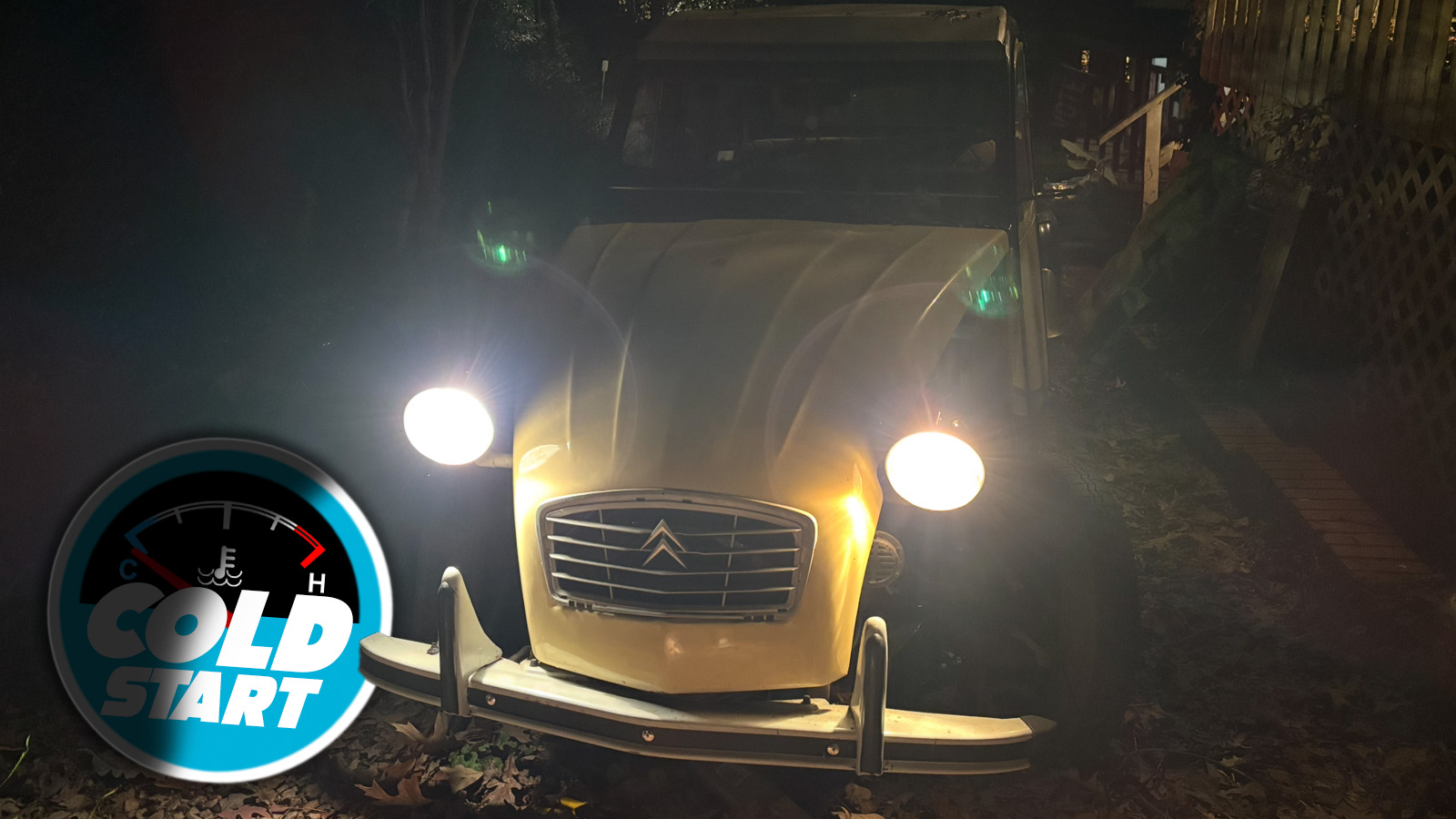


The first stop after Shannon was Liverpool! I got a couple of neat, if blurry photos of it coming in for landing at John Lennon Airport. It actually flew a few rounds over the city first, and I was hanging out clothes when I saw it. I caught the photos on its second and third passes (the last one being the one for landing).
How are they charging at airports that I assume are not setup for fast electric vehicle charging? 15 amp wall outlet and let it sit for a few weeks?
I wonder if they couldn’t replace one or two battery packs with an engine and generator range extender.
I bet the Beta’s Autopilot isn’t in beta test mode.
I’m loving the seagull shaped wings. Nature always finds the most efficient way to do things.
Neat that they’re making one and it’s not vaporware.
The bent wings give it a charmingly seagull-esque appearance. Imagine ordering uber eats and one of these brings you french fries.
This and its supposed use case in organ transplant transportation just smells of vaporware. The Airbus H145, probably the most widely used helicopter for medevac flights in the US has a rotor diameter of just over 36 feet (11 m). As did the Agusta A109s that used to be in use around here. The Bell 407, the only others I see bringing people having a bad day, has a diameter of 35 feet.
The Alia, with a 50-foot wingspan might be too big to fit on more than a few hospital helipads.
The lack of VTOL capabilities on the CX300 is pretty disqualifying.
I’m not rooting against them, but I just don’t see this coming to fruition.
Totally aside, I could probably be able to figure out the information displayed in front of me. But the instrument cluster (and likely FMS) doesn’t look anything like the steam gauge instruments and avionics in my old C-150. I guess you’re learning to fly in a 172 with a Garmin IP. Back when I was flying, we had paper charts and VORs.
I imagine Garmin is a pretty fun company to work for. I thought they were hosed when smart phones got GPS and mapping and all I thought they did was make cheap little navigators for us ground-bound drivers, but Garmin is doing some amazing stuff from what I’ve read. Good for them!
I know nothing of helicopters or planes, but I did wonder if 50 feet was a bit large. Thanks for this.
At the risk of sounding like a moron, what makes the four-corner drone-style props better than your standard rotor on a helicopter (or, I guess in this case, autogyro)? Torque? Footprint? Because even the body is basically shaped like a standard chopper.
I do like the wing design? Reminds be a bit of a seagull or some such.
Rotors in quad-copters can be fixed. You can control pitch and roll and even yaw with changes to rotor speed.
In a helicopter your main rotor needs to be articulated, plus the blades also need to change their pitch (collective), which adds complexity and more importantly, a lot of weight.
I would politely argue that multi-lift rotor systems weigh more per lift unit than a single rotor system would. Now, the chasm between electric lift motors versus combustion motors complicates matters massively, as electric motors can change speeds way faster than any turbine/large rotor system can, hence collective hardware, but electric motors and batteries weigh more than turbines, gearboxes, and mechanical control systems combined, which is why builders often choose to design single rotor copters over other layouts.
I sound like a moron all the time. Am I actually one? Maybe, probably, but no one really cares other than me.
Anyway, single main rotor aircraft require a tail rotor to counter torque. Multi-lift rotors can have counter rotating blades which natively neutralize rotational torque. That’s pretty much the reason. Drones are also usually small which make them more susceptible to rotation moments than larger craft due to plain old physics.
Awareness. That’s the key, IMO.
If you KNOW you have gaps in your knowledge or understanding, and are humble enough to admit it and learn, and —more importantly—jettison older knowledge that is outdated or just plain wrong, you’re not a moron. Far from it, by a long stretch.
A lot of society’s ills are rooted in breakdowns of the above. I’m sure a good sociologist could add or correct me, but I think I’m close.
Anyway, good on ‘ya, Crank.
Good they’re getting this debugged now so they’ll be ready once solid-state batteries hit the market, making it a lot more competitive. Wonder how TCO pencils out with the very different fuel and maintenance costs?
I used to believe solid-state batteries were a dream on par with fusion. But people keep making progress. If they ever get commercialized it will be a whole new day.
When a customer requests a particular configuration, by definition there is customer demand, and United parcel is notoriously focused on efficiency to the point of discouraging left turns.
I think the main reason for the existence of these companies is to attract investor dollars leading to (in the founders dreams) an IPO’s so the founders can cash out and buy an island. Batteries will not magically get better. Just like a thermal internal combustion engine, there are theoretical limits to the energy density of batteries. And it’s very limited. And despite the range, recharging the batteries is going to take a long time and recharging at destination is going to be virtually impossible. Certainly interesting technology but it’s time has not yet come. Planes aren’t like cars where you can throw stuff against the wall and see if it sticks. Planes have to work and their design evolution is very conservative, or people die.
“ Beta says the motor’s service ceiling is 14,000 feet”
Why? What happens at to an electric motor at 14,000 feet?
It’s an unpressurized plane so the ceiling is going to be 10,000 feet anyway. But as air thins at altitude, cooling may become an issue. They’d have to test it at higher altitudes to show that internal motor winding and inverter temperature limits are not exceeded.
So, the air may be really cold, but too thin to transfer heat?
A plane’s service ceiling is primarily determined by how much engine power can counteract the effects of decreased air density and temperature at higher altitudes, which reduces engine thrust and wing lift. – Google AI
Reads: The motor isn’t powerful enough to fly higher.
It can’t spin fast enough to fight against the thinning air and keep the aircraft flying. The motor itself would be fine, though.
All the fancy effort into low drag and light weight designs, carbon, etc are fine, but they only do that because the energy source is heavy, low density, and fixed weight (terrible), and so they have to push more cost and complexity into a lighter fuselage to make up for the awful energy source.
The same cost and materials tech could go into a plane with a ICE engine, and be very efficient.
So, they end up with something that I’m assuming performs like a Cessna, or worse, at max weight all the time, but which costs a lot more.
Wow, apparently you’ve completely forgotten about how ICE powertrain maintenance is orders of magnitude more complicated and expensive than EV motor maintenance.
Oh My God! Just the other day while I was flying to work, I saw one of those electric planes just engulfed in flames on the side of the flight path. Sooo Dangerous! I would never buy one. And they say it’s actually dirtier than jet fuel because the electricity comes from coal.
Hardy har har.
Airplanes and electrification. Talk about range anxiety!
Call up the “tanker” for mid air recharging.
That’s what lightning strikes are for. Power me up Zeus!
You say that, but you’re just inviting bird strikes from swans.
Wouldn’t this be a good application for hydrogen fuel cell? You don’t need to lug around all the weight of the batteries. I’m not really a fan of fuel cell technology as producing hydrogen is extremely energy intensive, but maybe here it works.
It could be, but likely synthetic fuel will be the future for aviation in areas where emissions are restricted.
Its almost a direct replacement for current fuels and the higher price is justified by the huge weight savings over electric.
One eVTOL company is flying using hydrogen fuel cells. Longer range.
https://verticalmag.com/news/joby-completes-landmark-523-mile-hydrogen-electric-vtol-flight/
The hydrogen has weight. They would use liquid hydrogen.
Aren’t package drones already capable of being able to deliver organ donations to a sister city or near by hospital far cheaper and safer?
In addition as bad as temperature changes affect range in cars how do they affect batteries in planes where the temperature is a bit chilly? I’d suggest working electric in the ocean going heaviest polluters on the planet next to Hollywood Special Effects.
I guess there is a niche for this sort of thing. But how much is it going to cost vs. a good old-fashioned Cessna Caravan that can do a whole lot more? UPS has deep pockets though. And once the charging infrastructure is in place, this would work for many of the routes that they use the Caravans for. Back in my bank courier days, one of my stops was the FBO at Portland, ME, where I met a couple of UPS flights from Northern Maine carrying the day’s checks down for processing (among other things of course). Those routes would be just about doable with this airplane (~300 miles from Ft. Kent to Portland). But probably not out west where the the distances are a lot farther. And the charging time would eat into the utilization of the aircraft. Unlike the jets that really only fly once a day, the Caravans made a LOT of flights a day feeding packages from various small towns to stuff the 727 (now 757) in Portland that flew them to Memphis late at night. And for the 7pm departure to Portland, two big bags of checks. Of course, checks aren’t physically shuffled around anymore for processing like 35 years ago. Damn, I am getting old! But the Caravans still fly around the state all day.
Will be very interesting to see how this all turns out. Lots of airplanes that were supposed to be “revolutionary” over the years that were flashes in the pan.
I’m fairly certain that aircraft engine maintenance is far more involved and expensive than car engine maintenance, so the much simpler EV powertrain would probably have massive savings.
Maybe. Nobody knows yet. All of it is done on a schedule. And with an electric motor, it’s going to be “at X hours, remove the whole thing and replace it”. And until there is LOTS of real-world experience, that interval will be SHORT. That won’t be cheap. Nothing that flies is.
This is a terrible misconception with people superficially knowledgeable on aircraft commercial operations. I have been flying both for the US Navy and NOAA (Hurricanes and surveys in Alaska). I went private and have owned two 135 charter operations with UPS contracts and overseas with scheduled service in Africa. What people do not ever seem to understand when you operate at max fuel load, you very rarely make any money, so rarely you go bankrupt. Almost all successful designs that have good profit margins in short haul, Caravans and Twin Otters, operate at roughly 30-40% of max fuel load. Electric planes operate at 100% fuel load, with no way to reduce the fuel load, for lets say better operating numbers, like climbing in icing, getting into shorter fields, or carrying heavy loads in icing onto a short field. I suppose if one flew from Burbank to John Wayne, then it might make sense, but there really has never been a short haul metropolitan airline that has not gone bankrupt. LA, New York, Toronto, London. Until the power density goes up at least another 50%, it is unlikely they will be able to operate profitably. That dream seems unlikely due to these pesky laws of physics. Only so many hops of electrons in orbits. Perhaps we need new physics laws?
If we can get new laws of physics by getting off this God-awful timeline we are on, I am all for it! The physics of flight are a bitch, far more so than for cars.
Well said, and based on my knowledge of the industry as an interested outsider with a couple freight-dog pilots (USAF then FedEx for both of them) in the family, spot on! People don’t get that airplanes can carry a lot of fuel, or a lot of stuff, but never both at the same time. So you end up with nutty things like the longest passenger flight in the world being all first and business class seats at a hugely premium price (and it still probably loses money most of the time).
You are very right that weight is the enemy of profit for planes. On the other hand, the efficiency is so much higher for the electric drive versus a turboprop to help offset the math.
Also, at least in the short term, the green image could land higher rates from charter customers.
People keep making this mistake, for any aerospace application that matters, it is not even remotely close to true. The actual capability of an aircraft is determined by the overall efficiency of the system, not just the propulsion element. So yes, the thermodynamic efficiency of an electric prop is indeed much higher than a dino juice burning one. The counterpoint is the energy needed to power that electric prop has to be stored in batteries that compared to jet fuel, are two orders of magnitude less efficiency in terms of W/kg. And since the energy use of an aerospace vehicle for any given cruise speed scales vs mass as the doubling of a square, that two orders of magnitude loss in storage efficiency becomes 4, and is then doubled. Which drags your total system efficiency into the abyss the second you start adding enough batteries to carry you any further.
So what you are seeing here, or something like Harbor Air’s eBeavers, represent a pretty hard limit on the mass you can fly any meaningful distance with BEV propulsion. Batteries have to get not just a little bit better, but orders of magnitude better to match the system efficiency of a turboprop.
Thank you for posting some sensible take. I’m not a pilot, just a physicist.
This seems related to the “tyranny of the rocket equation”. (Increasing payload requires exponentially more fuel). Designs rely on high energy density, and the wonderful fact that as the fuel burns it decreases weight.
Heavy batteries require more battery just to fly the weight of the batteries, and they don’t even burn off!
Wait, I’ve got my new company pitch! Battery powered rockets!! (Just need to scale up an ion drive.)
Just look at all the hazardous crap rockets spew out, mine will be clean and environmentally friendly!!! First launch sometime next year. I promise.
Now, send me all the money.
Yea if we reduce the gravitational force of the Earth we could fly planes much more easily!
You know, I’m about 99% certain that the Norwegian airline that has already taken possession of one of these planes has already thought through your icing concerns.
Real world, being able to cope with icing and being able to make a profit while doing it are two unrelated things. You have to significantly reduce your load to deal with the event you can pick up 1,000=2,000 lbs of ice. Just not possible with batteries. This is the real world of aviation, not the dreamer flying car and drone delivery world. I actually have had to deal with it, both as a pilot and an owner. Margins are razor thin in aviation. If all your money is in acquisition it will also reflect on your insurance costs, which for something like that would be 4.5% of hull value. This charge happens each and every month. BTW, Norway is not the real world, they can lose money on a business and the sovereign fund will make up the difference. Had experience, bought aircraft from operators there that they finally cut loose. So I have heard first hand.
I hope they invite you for a tour so there can be a Burlington or Plattsburgh meetup!